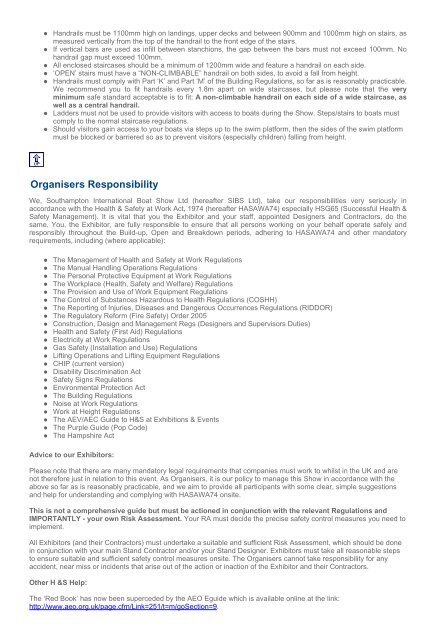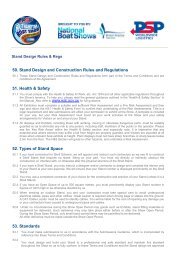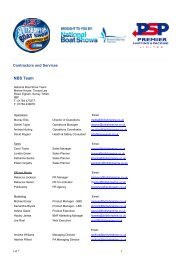Health & Safety Types of Stand Build and Submission Requirements
Health & Safety Types of Stand Build and Submission Requirements
Health & Safety Types of Stand Build and Submission Requirements
You also want an ePaper? Increase the reach of your titles
YUMPU automatically turns print PDFs into web optimized ePapers that Google loves.
• H<strong>and</strong>rails must be 1100mm high on l<strong>and</strong>ings, upper decks <strong>and</strong> between 900mm <strong>and</strong> 1000mm high on stairs, asmeasured vertically from the top <strong>of</strong> the h<strong>and</strong>rail to the front edge <strong>of</strong> the stairs.• If vertical bars are used as infill between stanchions, the gap between the bars must not exceed 100mm. Noh<strong>and</strong>rail gap must exceed 100mm.• All enclosed staircases should be a minimum <strong>of</strong> 1200mm wide <strong>and</strong> feature a h<strong>and</strong>rail on each side.• ‘OPEN’ stairs must have a “NON-CLIMBABLE” h<strong>and</strong>rail on both sides, to avoid a fall from height.• H<strong>and</strong>rails must comply with Part ‘K’ <strong>and</strong> Part ‘M’ <strong>of</strong> the <strong>Build</strong>ing Regulations, so far as is reasonably practicable.We recommend you to fit h<strong>and</strong>rails every 1.8m apart on wide staircases, but please note that the veryminimum safe st<strong>and</strong>ard acceptable is to fit: A non-climbable h<strong>and</strong>rail on each side <strong>of</strong> a wide staircase, aswell as a central h<strong>and</strong>rail.• Ladders must not be used to provide visitors with access to boats during the Show. Steps/stairs to boats mustcomply to the normal staircase regulations.• Should visitors gain access to your boats via steps up to the swim platform, then the sides <strong>of</strong> the swim platformmust be blocked or barriered so as to prevent visitors (especially children) falling from height.Organisers ResponsibilityWe, Southampton International Boat Show Ltd (hereafter SIBS Ltd), take our responsibilities very seriously inaccordance with the <strong>Health</strong> & <strong>Safety</strong> at Work Act, 1974 (hereafter HASAWA74) especially HSG65 (Successful <strong>Health</strong> &<strong>Safety</strong> Management). It is vital that you the Exhibitor <strong>and</strong> your staff, appointed Designers <strong>and</strong> Contractors, do thesame. You, the Exhibitor, are fully responsible to ensure that all persons working on your behalf operate safely <strong>and</strong>responsibly throughout the <strong>Build</strong>-up, Open <strong>and</strong> Breakdown periods, adhering to HASAWA74 <strong>and</strong> other m<strong>and</strong>atoryrequirements, including (where applicable):• The Management <strong>of</strong> <strong>Health</strong> <strong>and</strong> <strong>Safety</strong> at Work Regulations• The Manual H<strong>and</strong>ling Operations Regulations• The Personal Protective Equipment at Work Regulations• The Workplace (<strong>Health</strong>, <strong>Safety</strong> <strong>and</strong> Welfare) Regulations• The Provision <strong>and</strong> Use <strong>of</strong> Work Equipment Regulations• The Control <strong>of</strong> Substances Hazardous to <strong>Health</strong> Regulations (COSHH)• The Reporting <strong>of</strong> Injuries, Diseases <strong>and</strong> Dangerous Occurrences Regulations (RIDDOR)• The Regulatory Reform (Fire <strong>Safety</strong>) Order 2005• Construction, Design <strong>and</strong> Management Regs (Designers <strong>and</strong> Supervisors Duties)• <strong>Health</strong> <strong>and</strong> <strong>Safety</strong> (First Aid) Regulations• Electricity at Work Regulations• Gas <strong>Safety</strong> (Installation <strong>and</strong> Use) Regulations• Lifting Operations <strong>and</strong> Lifting Equipment Regulations• CHIP (current version)• Disability Discrimination Act• <strong>Safety</strong> Signs Regulations• Environmental Protection Act• The <strong>Build</strong>ing Regulations• Noise at Work Regulations• Work at Height Regulations• The AEV/AEC Guide to H&S at Exhibitions & Events• The Purple Guide (Pop Code)• The Hampshire ActAdvice to our Exhibitors:Please note that there are many m<strong>and</strong>atory legal requirements that companies must work to whilst in the UK <strong>and</strong> arenot therefore just in relation to this event. As Organisers, it is our policy to manage this Show in accordance with theabove so far as is reasonably practicable, <strong>and</strong> we aim to provide all participants with some clear, simple suggestions<strong>and</strong> help for underst<strong>and</strong>ing <strong>and</strong> complying with HASAWA74 onsite.This is not a comprehensive guide but must be actioned in conjunction with the relevant Regulations <strong>and</strong>IMPORTANTLY - your own Risk Assessment. Your RA must decide the precise safety control measures you need toimplement.All Exhibitors (<strong>and</strong> their Contractors) must undertake a suitable <strong>and</strong> sufficient Risk Assessment, which should be donein conjunction with your main <strong>St<strong>and</strong></strong> Contractor <strong>and</strong>/or your <strong>St<strong>and</strong></strong> Designer. Exhibitors must take all reasonable stepsto ensure suitable <strong>and</strong> sufficient safety control measures onsite. The Organisers cannot take responsibility for anyaccident, near miss or incidents that arise out <strong>of</strong> the action or inaction <strong>of</strong> the Exhibitor <strong>and</strong> their Contractors.Other H &S Help:The ‘Red Book’ has now been superceded by the AEO Eguide which is available online at the link:http://www.aeo.org.uk/page.cfm/Link=251/t=m/goSection=9.





